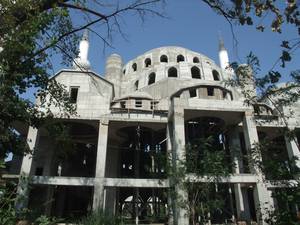Press Releases Archive
11.03.2016
Mosque building boom in Kyrgyzstan
PhD student investigates the revival of Islam for the Tübingen collaborative research center ResourceCultures
Islam is experiencing a revival in the former Soviet republic of Kyrgyzstan, with the number of mosques rising from 39 at independence in 1991 to some 2300 today. A field study by doctoral student Yanti Hölzchen of the collaborative research center ResourceCultures has found that at the same time, there is a desire among Kyrgyz of all ages to practise a moderate form of Islam - particularly among 20-40 year olds. Hölzchen is investigating the role of religion in Kyrgyzstan, which as a nation is undergoing considerable change.
At independence, the focus was on creating a new national identity and on a return to Kyrgyz traditions. For several years, the discourse has been dominated by a reformed Islam imported primarily from Turkey, South Asia, and Saudi Arabia. Cultural anthropologist Professor Roland Hardenberg is researching this reorientation within the ResourceCultures collaborative research center – investigating the role of Muslim foundations, religious schools and mosques as drivers of change in today’s Kyrgyzstan.
Islam and other religions were suppressed in Soviet times. Mosques and religious schools were destroyed, religious gatherings banned, Islamic scholars were persecuted and religious rituals were prohibited. Towards the end of the Soviet era there were few Kyrgyz with significant knowledge of religious practices or of the holy scriptures; to be Muslim was increasingly an ethnic characteristic – a Kyrgyz was a Muslim by definition, even if he or she did not believe in God or drank alcohol. The relatively sudden change in attitudes is reflected in the mosque building boom – but also in clothing, daily rituals and social ties, also subjects of Hardenberg’s research.
Hölzchen lived for twelve months in the Kyrgyz capital Bishkek and in the northeast of the country, living with local families, visiting mosques and madrasas, institutes of Theology, and Muslim foundations. She interviewed imams, practising Muslims, representatives of the media and of various Muslim institutions – exploring the reasons for the increase in mosque building, particularly in the past 15 years.
Nearly two-thirds of the mosques in the area Hölzchen investigated were financed by funds from Saudi Arabia, the rest from other Arab countries; but in many cases, village communities wanting a mosque used Kyrgyz foundations as mediators to arrange funding from abroad. The building boom also reflects the country’s economic development - many Kyrgyz cement their new wealth by building a mosque. And villagers working together make an important contribution to constructing a village place of worship. The way was paved by laws guaranteeing religious freedom introduced in 1991. They allow religious representatives and Muslim foundations from outside Kyrgyzstan to carry out their activities in the country; and native Kyrgyz can undergo religious training abroad, be part of a Muslim network, and make the pilgrimage to Mecca. Knowledge of the Koran and of Muslim values is being disseminated via mosques, madrasas, theological institutes and the activities of both Kyrgyz and foreign foundations. “The desire to learn all this, to teach and practise Islam by the book, is increasing in Kyrgyzstan, particularly among 20-40 year olds,” Hölzchen says.
Religious knowledge is becoming a resource; Hölzchen describes how it creates new communities and changes existing social relationships, values, and practices. She observes for instance how earlier Kyrgyz Muslim practices are increasingly being replaced by new ones which are more closely oriented towards the Koran and Sharia law. She says Islam has positive connotations in Kyrgyzstan: “Most Kyrgyz see it as a peaceful religion which urges its followers to morally better behavior. Many people say that today sales of cigarettes and alcohol are down, and that people are less aggressive. But it must be said that there is considerable fear of terrorism and extremism; and a lot of events are held - some of them in conjunction with international NGOs – to explain about extremist Islam.” Generally speaking, Christians and Muslims coexist peacefully in Kyrgyzstan, says Hölzchen: “My hope for Kyrgyzstan is that the atmosphere of tolerance I experienced there remains.”
Publication in preparation: "Religious education and cultural change – the case of madrasas in Northern Kyrgyzstan"
Contact:
Alexandra Niskios, M.A.
University of Tübingen
SFB 1070 ResourceCultures, Press Office
Phone +49 7071 29-73586
alexandra.niskios[at]uni-tuebingen.de
Yanti Hölzchen
SFB 1070 ResourceCultures, University of Tübingen
<link>yanti-martina.hoelzchen@uni-tuebingen.de
All Photos: Yanti Hölzchen
 | Public event marking the Festival of Mawlid, the Prophet’s birthday. |
 | Skeleton of the new central mosque in Bishkek |
 | Interior of the oldest mosque in northeastern Kyrgyzstan |
 | Muslim women in Bishkek |
